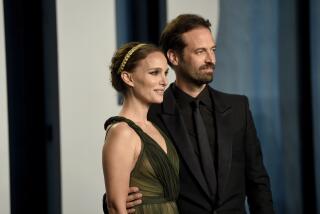Millepied, Muhly piece debuts at New York City Ballet spring gala
NEW YORK -- Fashion and ballet shared the spotlight at New York City Ballet’s French-themed spring gala Thursday evening. The program featured two world premieres; the more substantial of them, and the evening’s centerpiece, was Benjamin Millepied’s “Two Hearts,” set to a commissioned score by the increasingly busy and prolific Nico Muhly.
It was the fourth collaboration between the two, who will next join forces for the September debut of L.A. Dance Project at the Music Center. Natalie Portman, the choreographer’s wife, was the honorary chairwoman of the gala – a brisk two-hour program that got down to business without any speeches or acknowledgments.
The Gallic theme was solidified by the French scores – composed more than 150 years apart – for the other two ballets. Peter Martins’ brisk “Mes Oiseaux” used Marc-André Dalbavie’s 2009 Trio No. 1 as a springboard for a briskly efficient work for a quartet of young corps de ballet dancers. Setting a sole man (Taylor Stanley, whose juicy attack was notable) on stage with three women (Ashly Isaacs, Claire Kretzschmar and Lauren Lovette) might invite comparisons with George Balanchine’s masterwork “Apollo,” but there was no hint of timeless drama here. Each dancer bounded with high-octane force; each woman had a momentary duet with Stanley, with Isaacs’ being the most developed. But the main impression was one of bodies charging through space or being yanked harshly. French designer Gilles Mendel designed the sleek black costumes, with brightly colored underskirts for the women.
Millepied’s ballet also featured name-recognition costume design. His cast of 14 was dressed by Kate and Laura Mulleavy of Rodarte, in striking black and white marked by geometric patterning. (Up next for the Mulleavys is the costume design for the Los Angeles Philharmonic’s “Don Giovanni” beginning May 18.) The costumes seemed puzzlingly disconnected to the lyrical and pastoral tone of Millepied’s ballet, which marks a new maturity in its sophisticated yet unforced effects.
As he has in the past, Millepied proves he learned important lessons well from working with Jerome Robbins, and the ballet evokes youthful villagers in whose midst the central couple – Tiler Peck and Tyler Angle – are outsiders, somehow ill at ease and not fitting within its parameters.
The first of two extended duets, for which Muhly’s melancholy, lilting music effortlessly alludes to the past while sounding fresh, is marked by bracing fluency and suggests a dream interlude. They close the ballet in altered costumes – she’s in a sleek leotard, having shed her skirt – for an extended duet marked by images of suspension and wistfulness, culminating in loss. Muhly brings in a vocalist (Dawn Landes) for this concluding section to sing his arrangement of a traditional folk song that inspired the score.
The evening also featured Mark Happel’s new costumes for George Balanchine’s 1947 “Symphony in C” that maintained the repertory staple’s basic look -- traditional white tutus for the women and black tunics and tights for the men -- but updated their line and detail, adding decorative elements of Swarovski crystals. When Balanchine created this work, to a little-known Bizet symphony, for the Paris Opera Ballet, its title was “Le Palais de Cristal,” and each movement was costumed in a different color.
But there was no attempt to replicate that effect here; the Swarovski accents – muted bronze-colored, heart-shaped insets on the ballerinas’ satin bodices, and delicate silver lines accenting the tulle skirts – made no attempt to assign individual movements a distinctive look. Balanchine’s choreography – sumptuously elegant and endlessly inventive in its prismatic explorations of pristine classicism -- does that all by itself, and the steady crescendo of its brilliantly layered finale brought the evening to a suitably celebratory close.
ALSO:
Review: Ballet documentary ‘First Position’ entertains, uplifts
Benjamin Millepied and Music Center announce L.A. Dance Project
James Franco grabs another role with MOCA show on ‘Rebel Without a Cause’
More to Read
The biggest entertainment stories
Get our big stories about Hollywood, film, television, music, arts, culture and more right in your inbox as soon as they publish.
You may occasionally receive promotional content from the Los Angeles Times.










